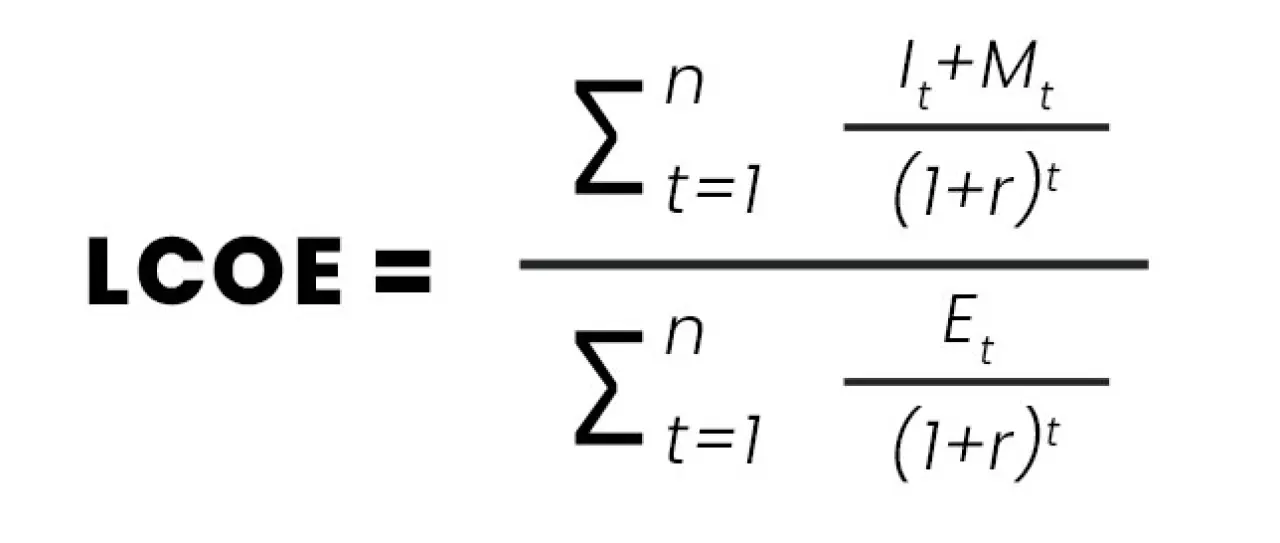Solar levelized cost of energy: Meaning, formula, and assessment


The levelized cost of energy (LCoE) refers to the average cost of the energy produced throughout the life of various energy-generating assets. In terms of power plants, LCoE is tied to how much it costs to generate a single unit of electricity over the lifetime of the plant. It’s often marked as dollars per megawatt hour ($/MWh).
LCoE is used to evaluate methods of energy production and can be considered as an average electricity price for a specific generation method to break even. The levelized cost of solar PV could potentially predict whether the project would, at a bare minimum, cover its own expenses or if the solar park doesn’t hold up against alternative choices.
The importance of solar LCoE
The investment-gain ratio is a fundamental part of any power plant. The LCoE of utility-scale photovoltaics (PV) is one of the essential assessments to determine if the project is viable and worth getting into. If the solar park can barely break even according to initial LCoE calculations, it might be better to move on to a project that shows more potential.
LCoE is primarily used by policymakers for long-term planning. The formula to calculate the LCoE seeks to assess a variety of factors that can be costly in the long run. Further, you may need to account for different factors, depending on the specific asset you’re making calculations for. For example, looking at the marginal costs to utilize coal, LCoE costs would have to include the price of coal as a material, while solar does not have such expenses.
However, it should be noted that these comparisons are often regarded as a guideline, not hard proof that the project is viable. Higher or lower LCoE is purely a theoretical prediction, but it’s one of the main elements that can influence investors’ interest, as it’s considered proof of the financial viability of solar PV power plants. LCoE calculations can even include tax benefits, such as depreciation of the installation.
LCoE formula and calculation
The costs calculated by LCoE can fall under three major categories: wholesale costs, retail costs and external (societal) costs. Additionally, calculations involved in the LCoE need to account for both the present values and the future values that will come into effect. Costs include financing, annual expenses and site irradiance characteristics.
Other important aspects of the formula include maintenance costs or even loans associated with various projects. The underperformance of any of these elements affects solar LCoE. For example, if the initial investment is quite large, but the overall yield of the project is low due to a poorly selected location which would require a lot of maintenance and upkeep, such a plant would likely be rejected as it would be deemed loss-making.
Here’s a breakdown of the formula:

It = Investment and expenditures for the year (t)
Mt = Operational and maintenance expenditures for the year (t)
Et = Electricity production for the year (t)
r = Discount rate that could be earned in alternative investments
n = Lifetime of the system
Units of measurement
LCoE is typically expressed in dollars per megawatt hour ($/MWh). A megawatt hour (MWh) represents 1,000 kilowatts of electricity generated per hour. As of 2023 in the United States, the global levelized cost of electricity for utility-scale solar PV ranged between $30 and $180 per megawatt hour.
However, it’s not enough to compare the projected cost against these averages. As mentioned previously, the value of output versus cost is the most important assessment that needs to be made. Ultimately, it doesn’t matter if the cost is more or less than is typical for solar PV; rather, it matters whether it’s cost-effective for the individual project and as compared to other options.
Solar LCoE compared to other renewable energy sources
Other renewable energy sources include options such as wind energy, geothermal energy, hydropower, and bioenergy. Each renewable resource is under constant innovation and development, and their feasibility and efficiency can reasonably be expected to shift and improve over time.
Solar and wind energy continue to consistently perform well in terms of cost per output compared to other options. However, again, the best option for a company will ultimately depend heavily on the scope and resources of each individual venture.
How to assess the value of solar LCoE?
So, what does this all mean in terms of what your company actually needs to do to determine whether solar power is the right option? A great start will be to do as follows:
- Assess the location. Consider the ease of access to both natural and manmade resources in the area, like exposure to sunlight and structural assets. This will ensure, for example, that there’s room for various roof and ground mounts.
- Review industry regulations. Consider the costs of adhering to all pertinent laws, regulations, and standards, both now and in the future.
- Calculate upfront costs. It’s important to know exactly how much a transition to solar energy will cost you upfront and how you intend to fund that upgrade in the short term.
- Estimate energy needs and output. Create a projection for your projects' base energy needs and compare this against the estimated output of a solar park.
- Conduct uncertainty and risk analyses. These analyses will seek to make room for unforeseen issues in your cost estimations.
- Compare different options for renewable energy. Obtain quotes and run tests to compare the output, cost, and efficiency of different options.
By taking these steps, you can more effectively assess the potential lifetime value of a solar energy upgrade for your specific projects and avoid any mishaps during the process.